This Wednesday, March 13th is Native American Lobby Day in Olympia.
Category: News
Native T-shirt company cracks the Walmart barrier
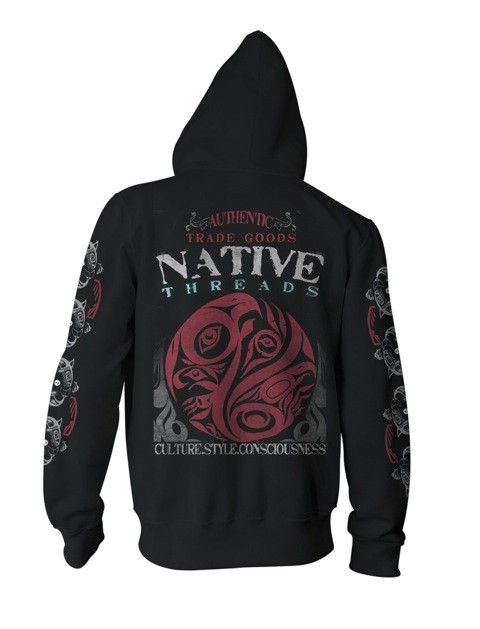
By Shondiin Silversmith
Navajo Times
WINDOW ROCK, March 7, 2013
A process that usually takes three to four years was swept through as a Native American T-shirt company got its product on the shelves of America’s largest retailer in less than one year.
Native Threads President Randy Bardwell, Pechanga Band of Luiseno Indians, said his company basically “busted the door down at Walmart” because a process he was told that takes years took Native Threads only six months.
“We did it really fast, and the reason it happened so fast is because we were able to put good information together for Walmart,” he said.

Native Threads’ first shipment officially hit the Walmart floor the weekend before Black Friday in 2012 with three original designs.
Bardwell said they had to drive five hours to get to the closest Walmart retailer that sold their product…across the state line in Arizona.
“It’s surreal,” said Bardwell. “The work that we put in to get it there makes it all worth it. It’s really a big sense of accomplishment.
“Not only are they the largest retailer in the world, but also they have so many stores that fit into our population demographic,” Bardwell said, noting that they took a lot of things into consideration before proceeding with the process.
“It wasn’t a decision that we took lightly. We had to consider what we had built without Walmart, and how we may alienate or affect our core shops – the people that really got us to where we are today,” Bardwell said. “We don’t want to put them in the same basket as Walmart.”
Bardwell said the way they did this was to create new designs specifically for Walmart, and they wouldn’t sell those designs through their core shops. It’s not only designs that changed, but the weight of the T-shirts as well.
Bardwell said the usual heavyweight T-shirts sold through the website and shops is not what is being sold at Walmart, because Walmart requires a lighter weight shirt, but the print quality is the same for both.
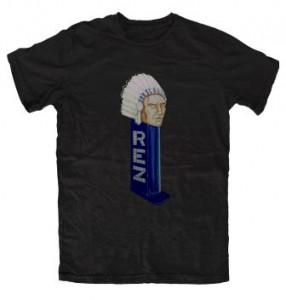
“Choosing Walmart as a partner was the right thing to do, not only from a sales standpoint,” Bardwell said, but because through Walmart they are able to sell their products at prices fit for everyone. “Walmart serves our population, and they can buy the quantities that can drive the price range to the 10-dollar range.”
Bardwell also believes that this partnership shows everyone that Native Americans are “sophisticated – we’re big picture thinkers and we’re true Native American entrepreneurs.”
Bardwell said that Native Threads can be found in over 120 stores until their spring release in May, when it will be cut back to around 70.
According to the Native Threads Website, Native Threads is one of Indian Country’s only Native-owned and operated clothing companies since their development in 1990. Bardwell said when they were first established they sold their products directly in various ways and that is how they started branching out.
“We went from direct retail selling to wholesale selling,” he noted.
“Our designs are contemporary, yet the messages are very traditional, cultural, and conscious of the current social, political and economic trends that affect Native peoples,” states the Native Threads Web site. “By combining these elements, our clothing helps give Native people clarity about who they are in this place and time. By providing constant reminders about our past, our products help bring to the surface the pride we carry inside of us.”
Information: http://www.nativethreads.com/.
Women’s History Month
How did March come to be Women’s History Month?
By Jone Johnson Lewis, About.com Guide
In 1911 in Europe, March 8 was first celebrated as International Women’s Day. In many European nations, as well as in the United States, women’s rights was a political hot topic. Woman suffrage — winning the vote — was a priority of many women’s organizations. Women (and men) wrote books on the contributions of women to history.
But with the economic depression of the 1930s which hit on both sides of the Atlantic, and then World War II, women’s rights went out of fashion. In the 1950s and 1960s, after Betty Friedan pointed to the “problem that has no name” — the boredom and isolation of the middle-class housewife who often gave up intellectual and professional aspirations — the women’s movement began to revive. With “women’s liberation” in the 1960s, interest in women’s issues and women’s history blossomed.
By the 1970s, there was a growing sense by many women that “history” as taught in school — and especially in grade school and high school — was incomplete with attending to “her story” as well. In the United States, calls for inclusion of black Americans and Native Americans helped some women realize that women were invisible in most history courses.
And so in the 1970s many universities began to include the fields of women’s history and the broader field of women’s studies.
In 1978 in California, the Education Task Force of the Sonoma County Commission on the Status of Women began a “Women’s History Week” celebration. The week was chosen to coincide with International Women’s Day, March 8.
The response was positive. Schools began to host their own Women’s History Week programs. The next year, leaders from the California group shared their project at a Women’s History Institute at Sarah Lawrence College. Other participants not only determined to begin their own local Women’s History Week projects, but agreed to support an effort to have Congress declare a national Women’s History Week.
Three years later, the United States Congress passed a resolution establishing National Women’s History Week. Co-sponsors of the resolution, demonstrating bipartisan support, were Senator Orrin Hatch, a Republican from Utah, and Representative Barbara Mikulski, a Democrat from Maryland.
This recognition encouraged even wider participation in Women’s History Week. Schools focused for that week on special projects and exhibitions honoring women in history. Organizations sponsored talks on women’s history. The National Women’s History Project began distributing materials specifically designed to support Women’s History Week, as well as materials to enhance the teaching of history through the year, to include notable women and women’s experience.
In 1987, at the request of the National Women’s History Project, Congress expanded the week to a month, and the U.S. Congress has issued a resolution every year since then, with wide support, for Women’s History Month. The U.S. President has issued each year a proclamation of Women’s History Month.
To further extend the inclusion of women’s history in the history curriculum (and in everyday consciousness of history), the President’s Commission on the Celebration of Women in History in America met through the 1990s. One result has been the effort towards establishing a National Museum of Women’s History for the Washington, DC, area, where it would join other museums such as the American History Museum.
The purpose of Women’s History Month is to increase consciousness and knowledge of women’s history: to take one month of the year to remember the contributions of notable and ordinary women, in hopes that the day will soon come when it’s impossible to teach or learn history without remembering these contributions.
Daylight Saving Time: Change Your Clocks on March 10
 You’ll want to think about going to bed early or sleeping in this weekend: Daylight Saving Time starts at 2 a.m. Sunday, March 10. That means you’ll spring ahead and move your clocks forward one hour — and, unfortunately, lose that hour of sleep.
You’ll want to think about going to bed early or sleeping in this weekend: Daylight Saving Time starts at 2 a.m. Sunday, March 10. That means you’ll spring ahead and move your clocks forward one hour — and, unfortunately, lose that hour of sleep.
The benefit is that we’ll get more sunlight later in the evening and it’s a pleasant sign that spring is just around the corner. Spring 2013 officially starts on Wednesday, March 20.
One drawback for Northern Virginia residents—Metro closed last year effectively one hour earlier than normal, since clocks jumped from 1:59 a.m. to 3 a.m., and 3 a.m. is Metro closing time. A few late-night partygoers in DC were caught off guard by the time change.
The Washington Metropolitan Area Transit Authority has not issued a press release regarding Daylight Saving 2013, but it is expected the same thing will happen.
Many electronic devices, like your cell phone and computer, automatically adjust when Daylight Savings Time begins or ends.
So, why do we do this at 2 a.m., and why shift our clocks at all?
According to Webhibit:
In the United States, 2 a.m. was originally chosen as the changeover time because it was practical and minimized disruption. Most people were at home and this was the time when the fewest trains were running. It is late enough to minimally affect bars and restaurants, and it prevents the day from switching to yesterday, which would be confusing. It is early enough that the entire continental U.S. switches by daybreak, and the changeover occurs before most early shift workers and early churchgoers are affected.
The larger reason for shifting our clocks, however, is energy conservation.
Ben Franklin first suggested shifting the clocks to save on candles, according to Discovery, but no one took him up on his idea at the time.
The first official national time shift wasn’t until 1918. Then the United States stopped the practice, started again during World War II for energy conservation reasons, stopped when the war was over and re-started with the Uniform Time Act in 1966. The Energy Policy Act of 2005 lengthened daylight saving to eight months instead of six months.
Does Daylight Saving actually save energy?
Discovery News reported:
Although a U.S. Department of Transportation study in the 1970s found that daylight saving trimmed electricity usage by about 1 percent, later studies have shown that the savings is offset by air conditioners running in warmer climates.
It may not all be for naught, however. Another study, performed in 2007 by the RAND Corporation found that the increase in daylight in spring led to a roughly 10 percent drop in vehicular crashes.
Check Your Smoke Detectors!
When you change your clocks in the fall and spring because of Daylight Saving Time, it’s also a good time to change batteries in your smoke and carbon monoxide detectors, and check to make sure the devices are in working order.
Arizona, Puerto Rico, Hawaii, U.S. Virgin Islands and American Samoa do not observe Daylight Saving Time.
Work expected to close Ebey Slough bridge over weekend
Herald Staff
MARYSVILLE — Unless it’s raining hard, the Highway 529 bridge into Marysville is set to close tonight and is scheduled to remain closed through the weekend.
People who drive the bridge over Ebey Slough will have to choose a different route from 8 tonight through 5 a.m. Monday. The weekend detour uses Fourth Street in Marysville and I-5. Bicyclists and pedestrians can be escorted through the closure if needed.
For the past year, demolition crews have used half of the new bridge as a staging area to rip down the old Ebey Slough bridge.
With the removal of the old bridge, drivers will finally be able to use all of the new, wider bridge after this last bit of work.
State Department of Transportation crews plan to remove the concrete barrier between drivers and the demolition staging area. Once the barrier is gone, the roadway will be striped for traffic in each direction. The bridge will reopen by Monday with four lanes for vehicle traffic and bike lanes on each side.
Transportation engineer Mark Sawyer anticipates that it will be a big change for drivers who use the bridge to commute and ease traffic during the evening commute from Everett.
When the weather improves in May, a final layer of asphalt will be applied.
The state built the new bridge to replace the 85-year-old Ebey Slough bridge.
For details, graphics and photos, go to www.wsdot.wa.gov/projects/sr529/ebeysloughbridge.
Watershed Heroes: Colville Confederated Tribes Win Sierra Club Award for Battling British Columbia Smelter
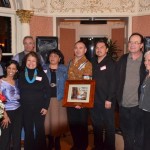
By Jack McNeel, Indian Country Today Media Network
The Colville Confederated Tribes’ successful effort to hold a British Columbia smelter accountable for dumping pollutants into the Columbia River for a century has caught the attention of the Sierra Club Washington State’s Upper Columbia River Group, which bestowed its 2013 Watershed Hero Award on the tribes.
Colville won a major victory in 2012 when the company, known today as Teck Metals Ltd. (formerly Teck/Cominco), admitted in court to depositing millions of tons of toxic substances into the river, which flows into Lake Roose-velt. Pollutants included 250,000 tons of zinc and lead, as well as 132,000 tons of other hazardous substances such as more than 200 tons of mercury, cadmium and arsenic.
The tribes, having pressed their case for two decades, also made legal history when the court struck down the notion that a foreign company could not be held liable under U.S. law. The victory was marked in high style on February 23 when Sierra Club leaders, including John Osburn, co-chair for Sierra Club’s Upper Columbia River group, joined tribal members in Spokane, Washington, for the presentation of its Water-shed Heroes honor at an awards dinner.
“Watershed Heroes are people who act out of love and respect for nature,” said Mary Verner, former director of Upper Columbia United Tribes and the former mayor of Spokane, who won the award last year and presented it this year.
“We’re very grateful for all the sacrifices you have made,” Verner said in introducing Colville Tribes chairman John Sirois and recognizing others from the tribes who had played major roles in the process.
“I’m grateful you relayed the history,” Sirois said. “I’m grateful for you honoring all the work of the past councils that really put in the time and effort. We have such a great legal team. There are countless people who played a role in this. It’s really a validation of who we are as a people. All along the river, those places are named after our people and where we come from: Okanogan, Chelan, Methow, Eniat, San Poil, Lakes, that is who we are. That is where our people are buried. That is where we’re born.”
Between 1896 and 1995, Teck’s smelter dumped 400 tons of waste a day—derived from the smelting process—into the Columbia River. The smelter is about 10 miles north of the U.S. border.
“It comes as no surprise that after being dumped into the Columbia River, all this toxic material flows downstream. The company tried to deny that,” Verner said. “Some of the most ridiculous arguments one has ever heard from a corporate entity have been raised by Teck/Cominco, now known as Teck Metals Ltd. The Colvilles weren’t having it.”
In the 1990s the tribes asked Canada to tell Teck to stop polluting the river, but Teck did not comply. The U.S. made similar attempts to stop the company but met with the same lack of results. In 2003 the U.S. Environmental Protection Agency identified Lake Roosevelt as a Superfund site and entered into an agreement with Teck to study the problem, making it clear that Teck would not be held responsible for the cleanup. But Teck found that unacceptable.
“In 2004 the tribes decided they could not wait any longer, and they filed a suit,” Verner said. Washington State eventually joined the tribes.
“To say the case of Pakootas v. Teck/Cominco is a landmark case would certainly be an understatement,” Verner said. “What a complex case it was! It has required navigating some incredible intricacies of the law, not even counting the science and politics.”
The tribes also got the court to overrule Teck’s argument that a company in another country cannot deliberately pollute U.S. waters and is not covered by U.S. law.
“The question is not where the polluter is located, but where the pollution is located,” Verner said. “It makes absolute sense, but the Colvilles had to fight for that outcome.”
Last April the court ruled that Teck could not escape liability. In September, Teck admitted it had knowingly and deliberately discharged 10 million tons of slag and toxic pollution into the Columbia. And in late 2012 a federal judge ruled that Teck qualifies as a polluter under the Superfund law.
“Heroes are tenacious,” Verner said of the tribes. “But it’s not over. Teck has appealed the ruling. They are trying to take this to the U.S. Supreme Court.”
As long as the bulk of the pollutants remain in the river or wash up on black beaches, the Colville Tribes will continue the battle. “Our future is about the water, all of us,” said Sirois. “We’re all in this fight together, to protect our environment, to protect our resources.”
Read more at http://indiancountrytodaymedianetwork.com/2013/03/06/watershed-heroes-colville-confederated-tribes-win-sierra-club-award-battling-british
Wayne Brady looks forward to bringing improv to Tulalip

Wayne Brady will perform in the Orca Ballroom at the Tulalip Resort Hotel and Casino on March 29.
By Kirk Boxleitner, Marysville Globe
TULALIP — The closest Wayne Brady has been to the Tulalip Resort Hotel and Casino is Seattle, but he told The Marysville Globe and The Arlington Times that he’s eager to try out a new venue.
“I’ll go wherever the audience is, from Manhattan to small towns,” Brady said, as he looked forward his two showings on March 29 in the Orca Ballroom. “And this won’t necessarily be the last time I’ll be here, either.”
Although Brady’s work in the entertainment industry ranges from starring roles in Broadway musicals to guest-starring parts on scripted TV shows and voiceover work for cartoons, many people probably know him best from his long-running stint as part of the cast on the improvisational comedy show “Whose Line Is It Anyway?” which will be returning with new episodes later this year. However, Brady has never seen such high-profile jobs as the end goal of his career, because throughout the rest of his hectic schedule he’s always found time to stay on the road.
“There are stand-ups who land those sitcom gigs because that’s what they were aiming for, but I’ve never stopped performing live,” Brady said. “It’s how I’ve stayed sharp. No matter what I’ve done, whether it was ‘Chicago’ or ‘Let’s Make a Deal,’ it would have suffered if I hadn’t kept doing that.”
According to Brady, he thrives on contact with live audiences, and described the sense of immediacy in their interactions as difficult to duplicate even in live television.
“There’s just this rush of instant reaction,” Brady said. “If you’re doing comedy onstage, you don’t have to wait for a critical review or a Nielsen rating. The club or theater or whatever the venue is will let you know, yea or nay, how they think you’re doing. It can be through a hush in the crowd or in the rattling of drinks, or more positive affirmation if you’re doing good. Either way, you get that feedback right away.”
Brady sees the challenges of live performance as akin to the enjoyable challenges that he feels everyone should choose to take on, regardless of their professions.
“The joy of live performance is that it’s live,” Brady said. “Nothing can replace it. Not everyone can do live performances, but we should all challenge ourselves, whether at work or in our lives.”
While Brady promised his Tulalip audiences that he would arrive fully engaged, he requested that they return the favor.
“I’m happy to come out here and bring my A-game, but I’d only ask that those who come out to see me do the same with their suggestions,” Brady said. “I’m going to challenge you guys too. This isn’t just going to be a show where you sit back and put your feet up. It’s improv, so you need to be ready for me to do anything, even if it means coming out into the crowd and interacting with you.”
Brady’s 8 p.m. show on March 29 is already sold out, but as of March 4, tickets were still available for his 11 p.m. show later that same night. For more information, log onto www.tulalipresort.com/entertainment/orca-ballroom.aspx.
Two Native American Men Indicted for Unlawfully Selling Eagle and Hawk Feathers
Indian Country Today Media Network
U.S. Attorney Barry Grissom announced March 6 in a U.S. Department of Justice news release that Ruben Dean Littlehead, 38, Lawrence, Kansas, and Brian K. Stoner, 32, Ponca City, Oklahoma, are charged with unlawfully selling feathers from eagles and hawks covered by a federal law protecting migratory birds. The crimes are alleged to have occurred in Douglas County, Kansas.
Federal law (Title 16, United States Code, Section 703) prohibits taking, killing or possessing migratory birds. The U.S. Fish and Wildlife Service maintains a National Eagle Repository in Colorado for the purpose of providing eagle feathers to Native Americans for use in Indian religious and cultural ceremonies. (For more information, see: Fws.gov/le/national-eagle-repository.html.)
The indictment alleges:
On September 15, 2008, Littlehead sold a bustle made with 68 feathers from a Golden eagle (Aquila chrysaetos).
On November 22, 2008, Littlehead sold 11 tail feathers and a wing from a Golden eagle (Aquila chrysaetos).
On February 26, 2009, Littlehead and Stoner offered for sale parts of a Bald eagle (Haliaeetus leucocephalus), a Golden Eagle (Aquila chrysaetos), and a Crested Caracara (Mexican Eagle, Caracara cheriway). They sold a tail feather fan made from feathers of a Bald eagle.
On February 26, 2009, they sold a bustle made of feathers of a rough-legged hawk and ferruginous hawk (Bueto lagopus and Buteo regalis).
If convicted, they face a maximum penalty of five years in federal prison and a fine up to $250,000 on each count. The U.S. Fish and Wildlife Service investigated. Assistant U.S. Attorney Randy Hendershot is prosecuting.
Court documents were not immediately available for review. Ruben Littlehead, Northern Cheyenne, is a top pow wow dancer and MC, who has emceed at major events such as the Gathering of Nations.
Read more at http://indiancountrytodaymedianetwork.com/2013/03/07/two-native-american-men-indicted-unlawfully-selling-eagle-and-hawk-feathers-148053
President Obama signs Violence Against Women Act
- By Julia Dahl, CBS News
(CBS) – On Thursday afternoon, President Obama signed into law the re-authorized Violence Against Women Act (VAWA). The act, originally passed in 1994, provides federal funding for programs and research aimed at preventing and prosecuting domestic and sexual violence.
The new version of the law includes several new measures, including granting Native American tribes jurisdiction to prosecute non-native perpetrators of domestic and sexual violence against native women. Previously, tribes had no jurisdiction over non-tribal members, even if they are married to native women or reside on native lands.
But, said Obama Thursday, “as soon as I sign this bill, that ends.”
According to Tina Olson, co-director of Mending the Sacred Hoop, an advocacy group dedicated to fighting violence against native women, as many as 50 percent of native women marry non-native men. This means that if they become victims of domestic violence, they have little recourse through the tribal justice system.
“It’s not as if native women want something unique,” says Olson. “They just want the justice other women get.”
Olson says she has “high hopes” about how the new law will help tribal women, but is taking a “wait and see” attitude until funds for enforcement – and consequences for failing to enforce – arrive.
In addition to the new provisions aiming to protect Native American women, the re-authorized VAWA allows groups representing Lesbian, Gay, Bisexual and Transgendered men and women to apply for grants to prevent sexual violence and care for victims. The new law also includes the SAFER Act, which aims to whittle down the backlog of DNA tests – often known as “rape kits” – in police storage around the country; and the Trafficking Victims Protection Reauthorization Act which provides services to victims of human trafficking.
VAWA expired in September 2011 and stalled in Congress after the House of Representatives balked at some of the new provisions in the version passed by the Senate. House Republicans drafted an alternative bill, but it failed when brought for a vote on Feb. 28. Later that day, the House voted 286 -138 to pass the Senate version.
Ariel Zwang, the CEO of SafeHorizon, a group that provides shelter and services to victims of domestic violence, says that as important as the new protections the reauthorized VAWA provides is the message the passage of the law sends to victims and perpetrators of domestic and sexual violence.
“Before VAWA, society’s response to domestic violence was basically to tell the guy to go walk around the block,” says Zwang. The law, she says, makes a national statement that “this is wrong, it’s a crime, and we’re going to talk about it and prosecute it.”
President Obama agreed, saying Thursday afternoon that the original law “made it possible for us to talk about domestic abuse.” The new law, he said, assists immigrant women whose status may be tied to an abusive spouse and “expanded housing assistance so that no woman has to choose between a violent home and no home at all.”
The signing coincides with a new report by the Department of Justice that shows that after declining between 1995-2005, the rate of sexual assault in the U.S. leveled off between 2005-2010. The new report also shows that fewer women are reporting sexual assault to police: in 2003, 56 percent of sexual assault victims reported to authorities, compared to just 35 percent in 2010.
Canned tuna recall due to bad seal or seam
The following canned tuna was shipped nationwide. Don’t take the chance of consuming a bad can.
Tri-Union Seafood Issues Voluntary Recall on Select 5-Ounce Chunk White Albacore Tuna in Water
FOR IMMEDIATE RELEASE – Mar. 6, 2013 – Tri-Union Seafoods LLC is voluntarily recalling a limited amount of Chicken of the Sea brand 5-ounce cans of chunk white albacore tuna in water.
The seams on the lids of the cans do not meet the standard for seam quality. Cans that do not meet seam standards could result in product contamination by spoilage organisms or by pathogens, which could lead to illness if consumed. There have been no reported illnesses to date, and Tri-Union Seafoods is issuing this voluntary recall to ensure the highest margin of safety and quality.
The specific product being recalled is Chicken of the Sea Brand 5-ounce chunk white albacore tuna in water sold at retail nationwide in single cans between February 4, 2013 and February 27, 2013.
The UPC code (also known as the bar code) is found on the label of the product and is 0 48000 03355 0. The Best By date is printed on the bottom of the can and is 01/18/17. The product lot codes that are part of this voluntary recall can also be found on the bottom of the can and include:
| CODE | BEST BY DATE |
| 3018CA2CKP | 01/18/17 |
| 3018CA3CKP | 01/18/17 |
| 3018CA4CKP | 01/18/17 |
| 3018CAACKP | 01/18/17 |
| 3018CABCKP | 01/18/17 |
| CODE | BEST BY DATE |
| 3018CACCKP | 01/18/17 |
| 3018CAECKP | 01/18/17 |
| 3018CB3CKP | 01/18/17 |
| 3018CADCKP | 01/18/17 |
“The health and safety of our consumers is paramount. As soon as we discovered the issue, we took immediate steps to issue this voluntary recall by alerting our customers who received the product and by asking them to remove it from store shelves,” said Shue Wing Chan, President of Tri-Union Seafoods.
No other codes of this product or other Chicken of the Sea products are affected by this voluntary recall.
Consumers looking for additional information can call our 24 hour Recall Information line at 1-800-597-5898.
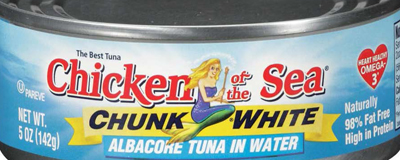
Bumble Bee Foods Issues Voluntary Recall On Specific Codes Of 5-Ounce Chunk White Albacore And Chunk Light Tuna Products Due To Loose Seals
FOR IMMEDIATE RELEASE – March 6, 2013 – Bumble Bee Foods, LLC, has issued a voluntary recall on specific codes of 5-ounce Chunk White Albacore and Chunk Light Tuna products. The recall has been issued because the products do not meet the company’s standards for seal tightness.
Loose seals or seams could result in product contamination by spoilage organisms or pathogens and lead to illness if consumed. There have been no reports to date of any illness associated with these products.
View more product photos here
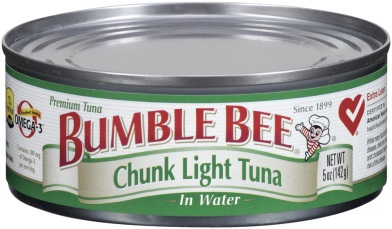
Products subject to recall follow:
Brunswick Brand 5oz Chunk Light Tuna in Water – 48 Count Case (Case UPC 6661332803)
| Can Label UPC | Can Lot Code | Can Best Buy Code |
| 6661332803 | 3018SB1CLP | Best By Jan 18 2016 |
| 6661332803 | 3018SB2CLP | Best By Jan 18 2016 |
Bumble Bee Brand 5oz Chunk Light Tuna in Water – 48 Count Case (Case UPC 8660000020)
| Can Label UPC | Can Lot Code | Can Best Buy Code |
| 866203 | 3016SBCCLP | Best By Jan 16 2016 |
| 866203 | 3016SBDCLP | Best By Jan 16 2016 |
| 866203 | 3016SBECLP | Best By Jan 16 2016 |
| 866203 | 3017SB1CLP | Best By Jan 17 2016 |
| 866203 | 3017SB3CLP | Best By Jan 17 2016 |
| 866203 | 3017SB4CLP | Best By Jan 17 2016 |
| 866203 | 3017SB5CLP | Best By Jan 17 2016 |
| 866203 | 3017SB6CLP | Best By Jan 17 2016 |
| 866203 | 3018SB2CLP | Best By Jan 18 2016 |
| 866203 | 3018SB4CLP | Best By Jan 18 2016 |
| 866203 | 3018SB5CLP | Best By Jan 18 2016 |
| 866203 | 3018SBACLP | Best By Jan 18 2016 |
| 866203 | 3018SBBCLP | Best By Jan 18 2016 |
| 866203 | 3018SBCCLP | Best By Jan 18 2016 |
| 866203 | 3018SBDCLP | Best By Jan 18 2016 |
| 866203 | 3018SBECLP | Best By Jan 18 2016 |
Bumble Bee Brand 5oz Chunk Light Tuna in Vegetable Oil – 48 Count Case (Case UPC 8660000021)
| Can Label UPC | Can Lot Code | Can Best Buy Code |
| 866213 | 3016SACCLH | Best By Jan 16 2016 |
| 866213 | 3016SADCLH | Best By Jan 16 2016 |
| 866213 | 3016SAECLH | Best By Jan 16 2016 |
| 866213 | 3016SAFCLH | Best By Jan 16 2016 |
| 866213 | 3018SAFCLH | Best By Jan 18 2016 |
Bumble Bee Brand 5oz Chunk White Albacore in Water – 24 Count Case (Case UPC 8660000025)
| Can Label UPC | Can Lot Code | Can Best Buy Code |
| 866253 | 3017SA1CKP | Best By Jan 17 2016 |
| 866253 | 3017SA2CKP | Best By Jan 17 2016 |
| 866253 | 3017SA3CKP | Best By Jan 17 2016 |
| 866253 | 3017SADCKP | Best By Jan 17 2016 |
| 866253 | 3017SAECKP | Best By Jan 17 2016 |
| 866253 | 3017SAFCKP | Best By Jan 17 2016 |
Bumble Bee Brand 5oz Chunk Light Tuna in Water – 6 Count Case of 4-Pack Cluster (Case UPC 8660000736)
| Cluster Pack UPC | Can Label UPC | Can Lot Code | Can Best Buy Code |
| 8660000736 | 866203 | 3017SBACLP | Best By Jan 17 2016 |
| 8660000736 | 866203 | 3017SBBCLP | Best By Jan 17 2016 |
| 8660000736 | 866203 | 3017SBCCLP | Best By Jan 17 2016 |
| 8660000736 | 866203 | 3017SBDCLP | Best By Jan 17 2016 |
| 8660000736 | 866203 | 3017SBECLP | Best By Jan 17 2016 |
Bumble Bee Brand 5oz Chunk White Albacore in Water – 6 Count Case of 8-Pack Cluster (Case UPC 8660000775)
| Cluster Pack UPC | Can Label UPC | Can Lot Code | Can Best Buy Code |
| 8660000776 | 866253 | 3017SABCKP | Best By Jan 17 2016 |
| 8660000776 | 866253 | 3017SADCKP | Best By Jan 17 2016 |
Bumble Bee Brand 5oz Chunk White Albacore in Water – 6 Count Case of 8-Pack Cluster (Case UPCS 8660000776)
| Cluster Pack UPC | Can Label UPC | Can Lot Code | Can Best Buy Code |
| 8660000776 | 866253 | 3017SA3CKP | Best By Jan 17 2016 |
| 8660000776 | 866253 | 3017SA4CKP | Best By Jan 17 2016 |
| 8660000776 | 866253 | 3017SA5CKP | Best By Jan 17 2016 |
| 8660000776 | 866253 | 3017SAACKP | Best By Jan 17 2016 |
| 8660000776 | 866253 | 3017SACCKP | Best By Jan 17 2016 |
| 8660000776 | 866253 | 3017SB2CKP | Best By Jan 17 2016 |
These products were distributed for retail sale nationwide between January 17, 2013 and February 28, 2013.
Bumble Bee Foods SVP of Technical Services and Corporate Quality Assurance Steve Mavity said: “Due to can integrity concerns, our top priority at this time is to remove these recalled products from distribution as soon as possible. We are working closely with our sales team and with retailers to help expedite the recall. We must assure our consumers and retailers of a safe and quality product so we very much appreciate everyone’s part in disposing of the products with the specific codes indicated.”
Mavity added, “There have been no consumer reports of illnesses attributed to these products, but because we’ve identified an issue with seal tightness, we’re voluntarily recalling products to ensure the highest margin of safety and quality.”
Consumers who have purchased the recalled products should discard the product by disposing in the garbage.
For any questions concerning this voluntary recall or reimbursement, consumers can contact Bumble Bee Consumer Affairs 24 hours a day at (800) 800-8572.
View all FDA recalls here










